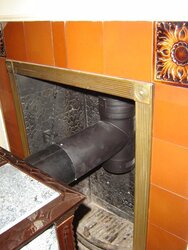Finally got our hands on a woodstove. Awesome. Now, about the installation... We plan to switch the openings so the pipe comes off the back of the stove instead of the top. It will then run straight into the existing fireplace and this is where we were wondering what to do. Some have advised that we seal off the fireplace front with steel and run the pipe into this. Others say you won't get as good a draft that way as running the pipe to a T and up, fitting it somehow to the existing damper opening (which looks kinda tricky). Is one way better than another?
Also, since this is the way we're leaning at the moment, with what and how would a person seal off the FP opening? It's a red brick front, then a layer of firebrick up the sides behind the red brick, then the steel box. And firebrick all across the bottom of the box. Would it fit against the redbrick, or the steel box or what? Would you have to fashion something removable for cleaning? Any thoughts at all would be splendifourus.
~K~
Also, since this is the way we're leaning at the moment, with what and how would a person seal off the FP opening? It's a red brick front, then a layer of firebrick up the sides behind the red brick, then the steel box. And firebrick all across the bottom of the box. Would it fit against the redbrick, or the steel box or what? Would you have to fashion something removable for cleaning? Any thoughts at all would be splendifourus.
~K~


